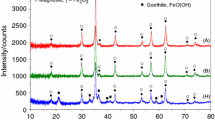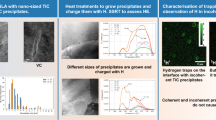Conclusions
The surfaces of the particles of a powder subjected to decarburizing-reducing annealing consist of masses of interwoven fibrous metallic formations, thanks to which the powder exhibits good compactibility. The fibrous formations have been found to have structural features suggesting that a gaseous phase participates in their growth. Material transfer is apparently effected by transport reactions. The transporting agent is carbon monoxide forming as a result of oxidation of carbon in the atomized particles by the oxygen of oxide phases during annealing. Growth of the fibrous formations is due to the carbonyl process, made possible by the structural features of the starting powder, which enable high gas pressures to be generated.
Similar content being viewed by others
Literature cited
É. Ch. Pioro et al., “Properties of an atomized iron powder of branched particle shape,” Poroshk. Metall., No. 10, 1–7 (1984).
E. I. Givargizov, Growth of Whiskers and Lamellar Crystals from Vapor [in Russian], Nauka, Moscow (1977).
A. F. Zhornyak and V. E. Oliker, “Reduction and decarburization during the annealing of atomized iron-carbon alloy powders,” Poroshk. Metall., No. 2, 5–15 (1982).
O. A. Esin and P. V. Gel'd, Physical Chemistry of Pyrometallurgical Processes [in Russian], Gos. Nauchno-Tekh. Izd. Lit. Chern. Tsvetn. Metall., Sverdlovsk (1962).
A. Ya. Kipnis, Carbonyl Metallurgy [in Russian], Obshch. Znanie, Moscow (1973).
N. A. Beiozerskii, Metal Carbonyls [in Russian], Metallurgiya, Moscow (1958).
B. S. Styskin, B. I. Bondarenko, A. A. Sigov, et al., “Reduction and swelling kinetics of iron ore pellets,” Izv. Akad. Nauk SSSR, Met., No. 3, 69–73 (1974).
R. Wagner and W. Ellis, “Vapor-liquid-solid mechanism of single crystal growth,” Appl. Phys. Lett.,4, No. 89, 89–90 (1964).
B. G. Gribov, G. A. Domrachev, B. V. Zhuk, et al., Deposition of Films and Coatings by the Decomposition of Metal-Organic Compounds [in Russian], Nauka, Moscow (1981).
T. Gabor and J. Blocher, “In situ electron-microscopic study of the growth of iron whiskers by chemical vapor deposition,” J. Appl. Phys.,40, No. 7, 2696 (1969).
F. Eisenkolb, Advances in Powder Metallurgy [Russian translation], Metallurgiya, Moscow (1969).
I. M. Fedorchenko and R. A. Andrievskii, Principles of Powder Metallurgy [in Russian], Izd. Akad. Nauk Ukr. SSR, Kiev (1963).
Yu. P. Gorlov, N. F. Eremin, and B. U. Sedunov, Refractory and Heat Insulating Materials [in Russian], Stroiizdat, Moscow (1976).
Author information
Authors and Affiliations
Additional information
Translated from Poroshkovaya Metallurgiya, No. 8 (272), pp. 16–22, August, 1985.
The authors wish to thank S. P. Gordienko for assistance with the mass-spectrometric investigation and E. I. Givargizov and S. M. Solonin for their interest in the work.
Rights and permissions
About this article
Cite this article
Pioro, N.C., Pioro, É.C., Zherdin, A.G. et al. Structural and morphological investigations of an atomized iron powder. Powder Metall Met Ceram 24, 598–603 (1985). https://doi.org/10.1007/BF00791945
Received:
Issue Date:
DOI: https://doi.org/10.1007/BF00791945




